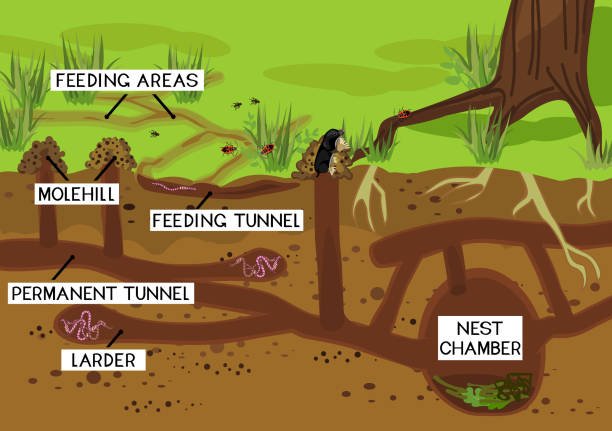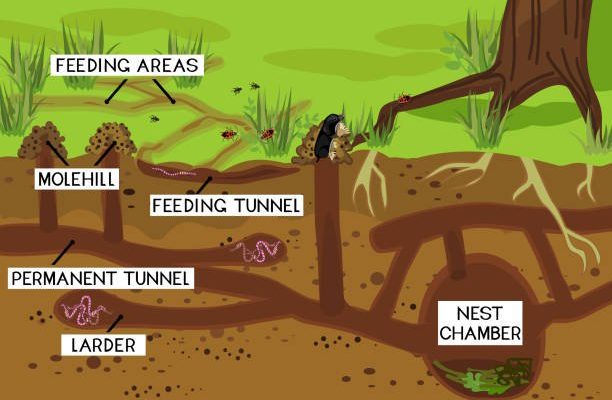
These little underground engineers don’t just help with air and water movement. They also play a crucial role in nutrient cycling. When earthworms consume organic matter like decaying leaves, they break it down and enrich the soil with vital nutrients. It’s like adding fertilizer without needing a bag from the store. So, understanding earthworm tunnels and soil structure is key if you’re looking to improve your garden or just have a better grasp of how ecosystems function.
Let’s dig deeper into the incredible world of earthworms and their tunnels!
What Are Earthworm Tunnels?
You might be wondering, “What exactly are these earthworm tunnels?” Well, they are the pathways created by earthworms as they move through the soil. These tunnels can vary in size, depending on the type of earthworm and the soil’s conditions. Some tunnels are tiny, while others can be quite large and noticeable.
When earthworms burrow, they consume soil and organic matter, which they digest and excrete as nutrient-rich castings. These tunnels not only provide homes for earthworms but also create channels that improve soil structure. A healthy soil structure means better water penetration, aeration, and root development for plants, which is essential for gardening and farming.
What’s fascinating is how these tunnels can change with the seasons. In wetter months, earthworms might create larger tunnels to avoid waterlogging, whereas in drier seasons, they may create shallower ones. These adaptations show just how responsive earthworms are to their environment.
The Role of Earthworms in Soil Quality
Earthworms are often called “nature’s plow” for a reason. They play a huge role in enhancing soil quality. When they tunnel through the soil, they break it up, allowing for better air circulation and water movement. This process helps create a more sustainable environment for plant roots to grow.
Imagine a sponge. If it’s compact and dry, it doesn’t absorb water well. However, once it’s expanded and full of holes, it can hold and distribute water efficiently. Earthworm tunnels do the same for soil, enabling it to retain moisture while also allowing excess water to drain away.
Additionally, earthworm castings—what they leave behind—are rich in nutrients. These natural fertilizers can boost plant health significantly compared to synthetic fertilizers. Plants love these nutrients, which is why gardens with healthy earthworm populations often flourish.
Soil Structure: Why It Matters
Soil structure is all about how soil particles are arranged. It affects everything from drainage to root growth. Imagine trying to walk on a beach versus walking on a grassy field. The beach sand is loose, while grass has a more compact structure that can support your weight. Similarly, soil that has a good structure supports plant life better than compact, unstructured soil.
Good soil structure involves aggregates—small clusters of soil particles that clump together. This clumping allows spaces for air and water to circulate. Earthworms enhance these aggregates by creating tunnels and depositing castings, which bind particles together. This process is vital for healthy ecosystems and agriculture.
Moreover, soil structure can influence how well plants absorb nutrients. When soil is well-aerated, plants can access the nutrients more easily, leading to healthier growth and higher yields.
The Impact of Earthworm Tunnels on Water Management
Water management is a big deal in gardening and farming. Earthworm tunnels greatly influence how water moves through the soil. Think of earthworm tunnels as tiny highways for water. When it rains, water can flow quickly into these tunnels, reducing runoff and preventing erosion.
By allowing water to move deep into the soil, earthworm tunnels enhance the soil’s ability to store moisture. This is especially important in areas prone to drought. With well-structured soil, plants can tap into stored water and thrive even during dry spells.
Additionally, the presence of earthworms can reduce the likelihood of waterlogging. Waterlogged soils can suffocate plant roots and lead to rot. Earthworms help maintain a balance by providing pathways for excess water to escape, ensuring that roots have the oxygen they need to grow.
Building Healthy Soil: Encouraging Earthworms
If you’re eager to boost your garden’s health, encouraging earthworms is a fantastic idea. Here are some tips to create a welcoming environment for these squirmy friends:
- Avoid chemical pesticides and fertilizers: These can harm earthworms and disrupt their habitat.
- Add organic matter: Compost and mulch provide food for earthworms and help improve soil structure.
- Keep the soil moist: Earthworms thrive in damp environments, so regular watering is beneficial (but avoid overwatering!).
- Practice no-till gardening: Tilling can disrupt earthworm habitats. Let them work their magic naturally.
Creating a hospitable environment can nurture a thriving earthworm population, which, in turn, enhances soil health.
Common Misconceptions About Earthworms
Despite their importance, there are some common misconceptions about earthworms that can lead to confusion. One of the biggest myths is that all earthworms are the same. In reality, there are over 7,000 known species! Some prefer wetter environments, while others thrive in dry soils.
Another misconception is that earthworms only help with soil in gardens. While they do enrich garden soil, they are equally essential in agricultural settings, forests, and even lawns. Their tunneling actions help improve the soil structure everywhere they’re found.
Finally, some people think earthworms are just an annoyance. But in truth, they are beneficial allies in maintaining a balanced ecosystem. Embracing earthworms in your soil management practices can lead to healthier plants and better food production.
Understanding earthworm tunnels and soil structure opens up a fascinating world of benefits for gardening and farming. These tiny, often overlooked creatures play an essential role in improving soil health, enhancing water management, and supporting plant growth. By nurturing earthworm populations, you can create a thriving ecosystem right in your backyard.
So next time you see an earthworm, remember its vital contributions to the soil beneath your feet. They truly are unsung heroes of the ecosystem, working tirelessly to keep our earth healthy. Whether you’re an avid gardener or just curious about nature, appreciating these little creatures can lead to a deeper understanding of the world around us. Get out there, dig a little, and let the earthworms do their thing!

